Physical Address
304 North Cardinal St.
Dorchester Center, MA 02124
In addition to conducting air to and from the lungs, the nose, mouth and pharynx have other important functions including speech, swallowing and airway protection.
Starting at the trachea, the airway divides about 23 times, terminating in an estimated 30 000 pulmonary acini, each containing more than 10 000 alveoli.
The alveolar wall is ideally designed to provide the minimal physical barrier to gas transfer, whilst also being structurally strong enough to resist the large mechanical forces applied to the lung.
This chapter is not a comprehensive account of respiratory anatomy but concentrates on those aspects that are most relevant to an understanding of function. The respiratory muscles are covered in Chapter 5 .
Breathing is normally possible through either the nose or the mouth, the two alternative air passages converging in the oropharynx. Nasal breathing is the norm and has two major advantages over mouth breathing: filtration of particulate matter by the vibrissae hairs and better humidification of inspired gas. Humidification by the nose is highly efficient because the nasal septum and turbinates increase the surface area of mucosa available for evaporation and produce turbulent flow, increasing contact between the mucosa and air. However, the nose may offer more resistance to airflow than the mouth, particularly when obstructed by polyps, adenoids or congestion of the nasal mucosa. Nasal resistance may make oral breathing obligatory, and many children and adults breathe only or partly through their mouths at rest. With increasing levels of exercise in normal adults, the respiratory minute volume increases, and at a level of around 35 L.min −1 the oral airway comes into play. Deflection of gas into either the nasal or the oral route is under voluntary control and accomplished with the soft palate, tongue and lips. These functions are best considered in relation to a midline sagittal section ( Fig. 1.1 ).
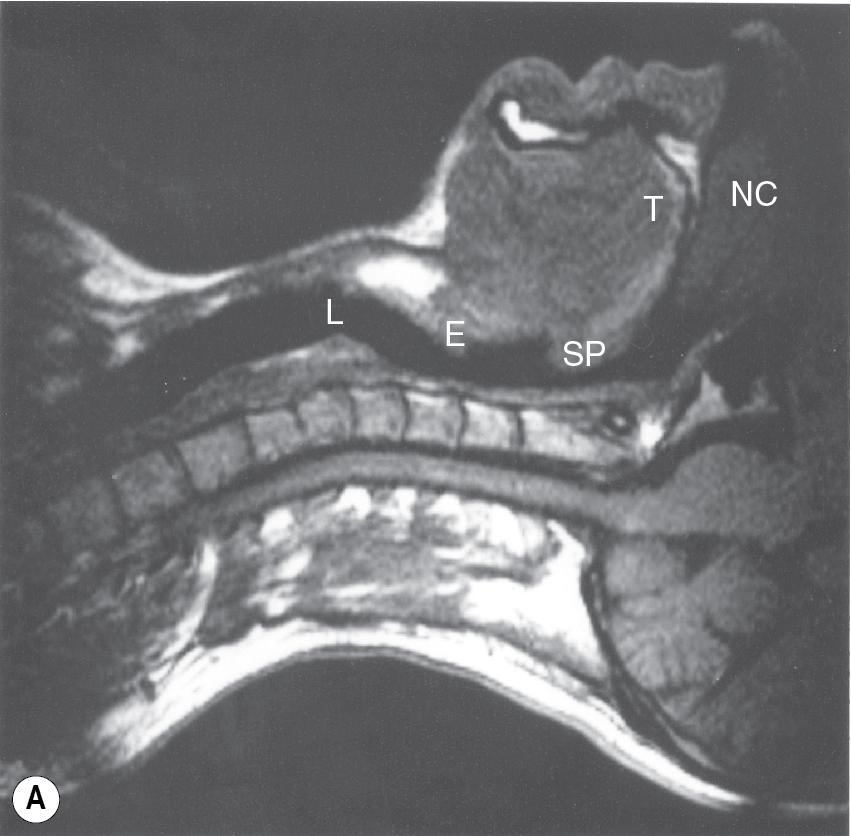
Figure 1.1 , A, shows the normal position for nose breathing: the mouth is closed by occlusion of the lips, and the tongue is lying against the hard palate. The soft palate is clear of the posterior pharyngeal wall. Figure 1.1 , B, shows forced mouth breathing, for instance when blowing through the mouth without pinching the nose. The soft palate becomes rigid and is arched upwards and backwards by contraction of tensor and levator palati to lie against a band of the superior constrictor of the pharynx known as Passavant’s ridge, which, together with the soft palate, forms the palatopharyngeal sphincter. Note also that the orifices of the pharyngotympanic (Eustachian) tubes lie above the palatopharyngeal sphincter and can be inflated by the subject only when the nose is pinched. As the mouth pressure is raised, this tends to force the soft palate against the posterior pharyngeal wall to act as a valve. The combined palatopharyngeal sphincter and valvular action of the soft palate is very strong and can easily withstand mouth pressures in excess of 10 kPa (100 cmH 2 O).
Figure 1.1 , C, shows the occlusion of the respiratory tract during a Valsalva manoeuvre. The airway is occluded at many sites: the lips are closed, the tongue is in contact with the hard palate anteriorly, the palatopharyngeal sphincter is tightly closed, the epiglottis is in contact with the posterior pharyngeal wall, and the vocal folds are closed, becoming visible in the midline in the figure.
During swallowing the nasopharynx is occluded by contraction of both tensor and levator palati. The larynx is elevated 2 to 3 cm by contraction of the infrahyoid muscles, stylopharyngeus and palatopharyngeus, coming to lie under the epiglottis. In addition, the aryepiglottic folds are approximated, causing total occlusion of the entrance to the larynx. This extremely effective protection of the larynx is capable of withstanding pharyngeal pressures as high as 80 kPa (800 cmH 2 O), which may be generated during swallowing.
Upper airway cross-sectional areas can be estimated from conventional radiographs, magnetic resonance imaging (MRI) as in Figure 1.1 or acoustic pharyngometry. In the latter technique, a single sound pulse with a duration of 100 μs is generated within the apparatus and passes along the airway of the subject. Recording of the timing and frequency of sound waves reflected back from the airway allows calculation of the cross-sectional area, which is then presented as a function of the distance travelled along the airway ( Fig. 1.2 ). Acoustic pharyngometry measurements correlate well with MRI scans of the airway, and the technique is now sufficiently developed for use in clinical situations such as estimating airway size in patients with sleep-disordered breathing ( Chapter 14 ).
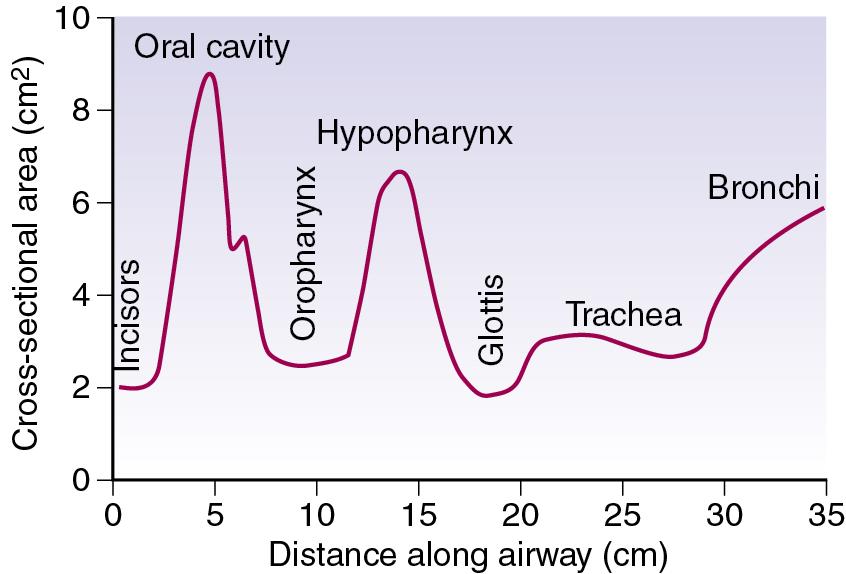
The larynx evolved in the lungfish for the protection of the airway during such activities as feeding and perfusion of the gills with water. Although protection of the airway remains important, the larynx now has many other functions, all involving some degree of laryngeal occlusion.
Phonation, the laryngeal component of speech, requires a combination of changes in position, tension and mass of the vocal folds (cords). Rotation of the arytenoid cartilages by the posterior cricoarytenoid muscles opens the vocal folds, while contraction of the lateral cricoarytenoid and oblique arytenoid muscles opposes this. With the vocal folds almost closed, the respiratory muscles generate a positive pressure of 5 to 35 cmH 2 O, which may then be released by slight opening of the vocal folds to produce sound waves. The cricothyroid muscle tilts the cricoid and arytenoid cartilages backwards and also moves them posteriorly in relation to the thyroid cartilage. This produces up to 50% elongation and therefore tensioning of the vocal folds, an action opposed by the thyroarytenoid muscles, which draw the arytenoid cartilages forwards towards the thyroid, shortening and relaxing the vocal folds. Tensioning of the folds results in both transverse and longitudinal resonance of the vocal fold, allowing the formation of complex sound waves. The deeper fibres of the thyroarytenoids comprise the vocales muscles, which exert fine control over the pitch of the voice by creating slight variations in both the tension and mass of the vocal folds. A more dramatic example of the effect of vocal fold mass on voice production occurs with inflammation of the laryngeal mucosa and the resulting hoarse voice or complete inability to phonate.
Tighter occlusion of the larynx, known as effort closure, is required for making expulsive efforts. It is also needed to lock the thoracic cage, securing the origin of the muscles of the upper arm arising from the rib cage, thus increasing the power which can be transmitted to the arm. In addition to simple apposition of the vocal folds described previously, the aryepiglottic muscles and their continuation, the oblique and transverse arytenoids, act as a powerful sphincter capable of closing the inlet of the larynx by bringing the aryepiglottic folds tightly together. The full process enables the larynx to withstand the highest pressures which can be generated in the thorax, usually at least 12 kPa (120 cmH 2 O) and often more. Sudden release of the obstruction is essential for effective coughing (page 46), when the linear velocity of air through the larynx is said to approach the speed of sound.
Laryngeal muscles are involved in controlling airway resistance, particularly during expiration, and this aspect of vocal fold function is described in Chapter 5 .
An accurate and complete model of the branching pattern of the human bronchial tree remains elusive, although several different models have been described. The most useful and widely accepted approach remains that of Weibel, who numbered successive generations of air passages from the trachea (generation 0) down to alveolar sacs (generation 23). This ‘regular dichotomy’ model assumes that each bronchus regularly divides into two approximately equal size daughter bronchi. As a rough approximation it may therefore be assumed that the number of passages in each generation is double that in the previous generation, and the number of air passages in each generation is approximately indicated by the number 2 raised to the power of the generation number. This formula indicates one trachea, two main bronchi, four lobar bronchi, 16 segmental bronchi and so on. However, this mathematical relationship is unlikely to be true in practice, where bronchus length is variable, pairs of daughter bronchi are often unequal in size, and trifurcations may occur.
Work using computed tomography to reconstruct, in three dimensions, the branching pattern of the airways has shown that a regular dichotomy system does occur for at least the first six generations. Beyond this point, the same study demonstrated trifurcation of some bronchi and airways that terminated at generation 8. Table 1.1 traces the characteristics of progressive generations of airways in the respiratory tract.
| Generation | Number | Mean Diameter (mm) | Area Supplied | Cartilage | Muscle | Nutrition | Emplacement | Epithelium | ||
|---|---|---|---|---|---|---|---|---|---|---|
| Trachea | Conducting airways | 0 | 1 | 18 | Both lungs | U-shaped | Links open end of cartilage | Columnar ciliated epithelium | ||
| Main bronchi | 1 | 2 | 12 | Individual lungs | From the bronchial circulation | Within connective tissue sheath alongside arterial vessels | ||||
| Lobar bronchi | 2 ↓ 3 |
4 ↓ 8 |
8 ↓ 5 |
Lobes | Irregular shape | Helical bands | ||||
| Segmental bronchi | 4 | 16 | 4 | Segments | ||||||
| Small bronchi | 5 ↓ 11 |
32 ↓ 2000 |
3 ↓ 1 |
Secondary lobules | ||||||
| Bronchioles Terminal bronchioles |
12 ↓ 14 |
4000 ↓ 16 000 |
1 ↓ 0.7 |
Pulmonary acinus | Absent | Strong helical muscle bands | Embedded directly in the lung parenchyma | Cuboidal | ||
| Respiratory bronchioles | Acinar airways | 15 ↓ 18 |
32 000 ↓ 260 000 |
0.4 | Muscle bands between alveoli | From the pulmonary circulation | Cuboidal to flat between alveoli | |||
| Alveolar ducts | 19 ↓ 22 |
520 000 ↓ 4 000 000 |
0.3 | Thin bands in alveolar septa | Form the lung parenchyma | Alveolar epithelium | ||||
| Alveolar sacs | 23 | 8 000 000 | 0.2 |
The adult trachea has a mean diameter of 1.8 cm and length of 11 cm. Anteriorly it comprises a row of U-shaped cartilages which are joined posteriorly by a fibrous membrane incorporating the trachealis muscle ( Fig. 1.3 ). The part of the trachea in the neck is not subjected to intrathoracic pressure changes, but it is very vulnerable to pressures arising in the neck due, for example, to tumours or haematoma formation. An external pressure of the order of 4 kPa (40 cmH 2 O) is sufficient to occlude the trachea. Within the chest, the trachea can be compressed by raised intrathoracic pressure during, for example, a cough, when the decreased diameter increases the linear velocity of gas flow, and therefore the efficiency of removal of secretions (page 47).
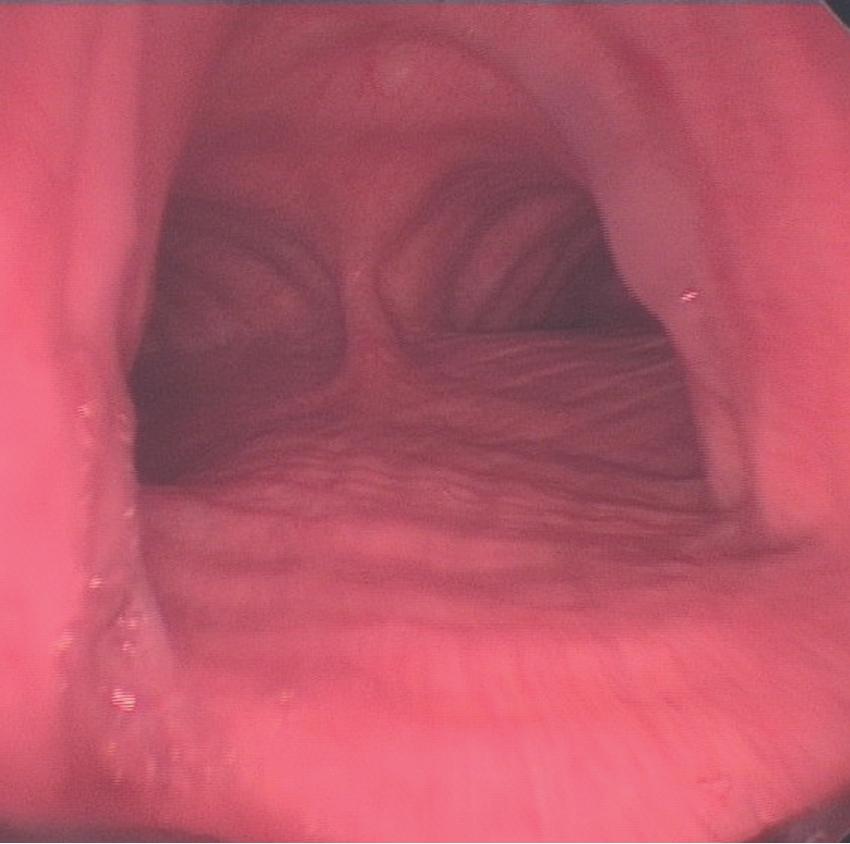
The trachea bifurcates asymmetrically, and the right bronchus is wider and makes a smaller angle with the long axis of the trachea. Foreign bodies therefore tend to enter the right bronchus in preference to the left. Main, lobar and segmental bronchi have firm cartilaginous support in their walls that is U-shaped in the main bronchi, but in the form of irregularly shaped and helical plates lower down, with bronchial muscle between. Bronchi in this group (down to generation 4) are sufficiently regular to be individually named ( Fig. 1.4 ). The total cross-sectional area of the respiratory tract is minimal at the third generation ( Fig. 1.5 ).
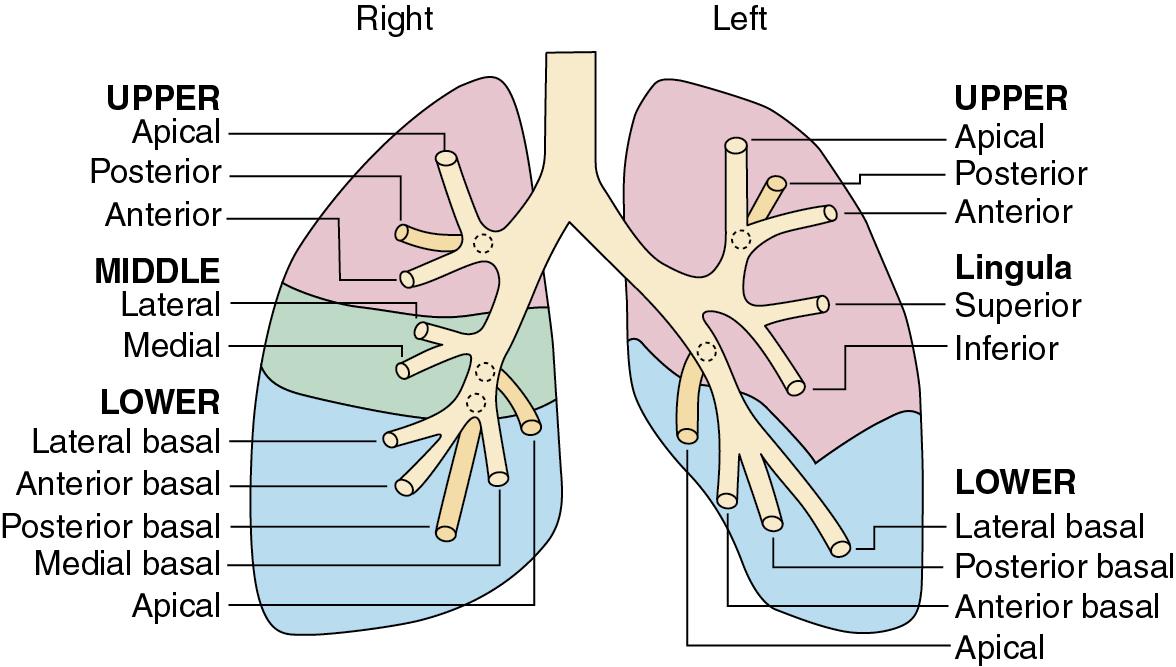
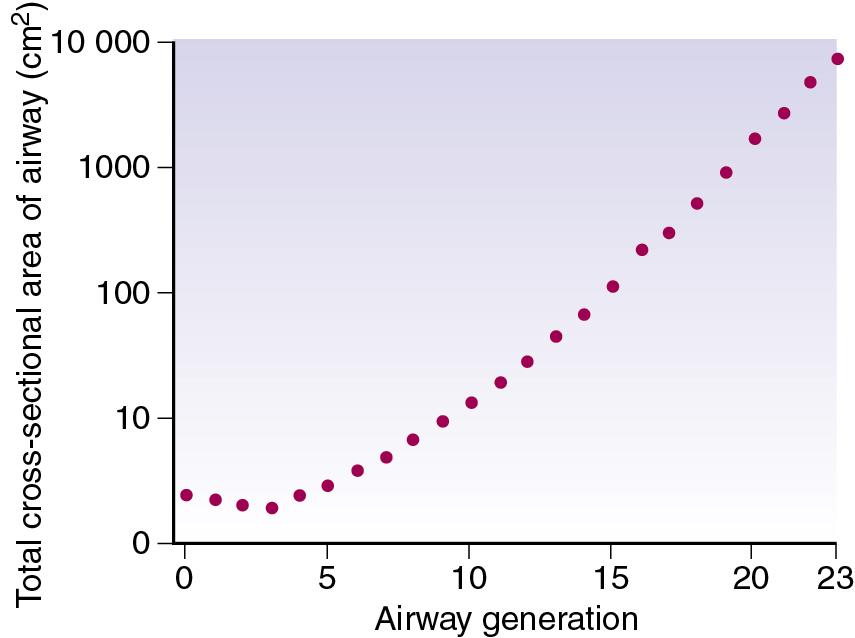
These bronchi are subjected to the full effect of changes in intrathoracic pressure and will collapse when the intrathoracic pressure exceeds the intraluminar pressure by around 5 kPa (50 cmH 2 O). This occurs in the larger bronchi during a forced expiration, limiting peak expiratory flow rate (see Fig. 3.7 ).
The small bronchi extend through about seven generations, with their diameter progressively falling from 3.5 to 1 mm. Down to the level of the smallest true bronchi, air passages lie in close proximity to branches of the pulmonary artery in a sheath containing pulmonary lymphatics, which can be distended with oedema fluid, giving rise to the characteristic ‘cuffing’ responsible for the earliest radiographic changes in pulmonary oedema. Because these air passages are not directly attached to the lung parenchyma, they are not subject to direct traction and rely for their patency on cartilage within their walls and on the transmural pressure gradient, which is normally positive from lumen to intrathoracic space. In the normal subject this pressure gradient is seldom reversed and, even during a forced expiration, the intraluminar pressure in the small bronchi rapidly rises to more than 80% of the alveolar pressure, which is more than the extramural (intrathoracic) pressure.
An important change occurs at about the 11th generation, where the internal diameter is around 1 mm. Cartilage disappears from the airway wall below this level and ceases to be a factor in maintaining patency. However, beyond this level the air passages are directly embedded in the lung parenchyma, the elastic recoil of which holds the air passages open like the guy ropes of a tent. Therefore the calibre of the airways beyond the 11th generation is mainly influenced by lung volume because the forces holding their lumina open are stronger at higher lung volumes. The converse of this factor causes airway closure at reduced lung volume (see Chapter 3 ). In succeeding generations, the number of bronchioles increases far more rapidly than the calibre diminishes ( Table 1.1 ). Therefore the total cross-sectional area increases until, in the terminal bronchioles, it is about 100 times the area at the level of the large bronchi ( Fig. 1.5 ). Thus the flow resistance of these smaller air passages (<2 mm diameter) is negligible under normal conditions. However, the resistance of the bronchioles can increase to very high values when their strong helical muscular bands are contracted by the mechanisms described in Chapters 3 and 28 . Down to the terminal bronchiole the air passages are referred to as conducting airways, which derive their nutrition from the bronchial circulation and are thus influenced by systemic arterial blood gas levels. Beyond this point the smaller air passages are referred to as acinar airways and rely upon the pulmonary circulation for their metabolic needs.
Down to the smallest bronchioles, the functions of the air passages are solely conduction and humidification. Beyond this point there is a gradual transition from conduction to gas exchange. In the four generations of respiratory bronchioles there is a gradual increase in the number of alveoli in their walls. Like the bronchioles, the respiratory bronchioles are embedded in lung parenchyma; however, they have a well-defined muscle layer with bands which loop over the opening of the alveolar ducts and the mouths of the mural alveoli. There is no significant change in the calibre of advancing generations of respiratory bronchioles (∼0.4 mm diameter).
Alveolar ducts arise from the terminal respiratory bronchiole, from which they differ by having no walls other than the mouths of mural alveoli (∼20 in number). The alveolar septa comprise a series of rings forming the walls of the alveolar ducts and containing smooth muscle. Approximately 35% of the alveolar gas resides in the alveolar ducts and the alveoli that arise directly from them.
Become a Clinical Tree membership for Full access and enjoy Unlimited articles
If you are a member. Log in here